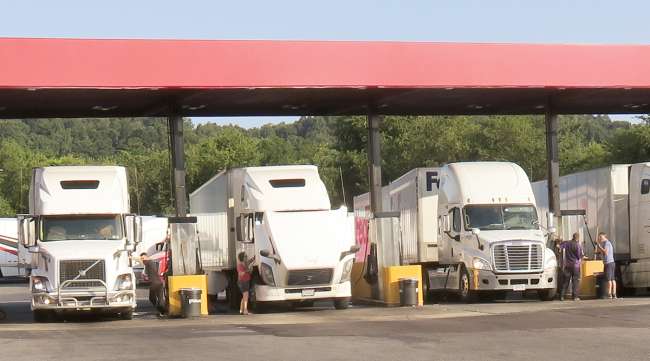Senior Reporter
Diesel Sheds 4.1¢ a Gallon to $2.507 as Slide Continues

[Stay on top of transportation news: Get TTNews in your inbox.]
Diesel fuel prices continued their steady downward slide April 13, according to the Energy Information Administration.
Trucking’s main fuel fell 4.1 cents to $2.507 a gallon, and it now is more than 61 cents per gallon below what it cost one year ago.
Prices fell in all 10 regions of the country that the EIA monitors in its weekly diesel and gasoline report.

The industry is struggling to attract a new generation of technicians to maintain and repair increasingly high-tech trucks. Seth Clevenger spoke in Atlanta with Technology & Maintenance Council President Robert Braswell and Chairman Stacy Earnhardt to find out who's fixing the trucks of tomorrow. Hear a snippet, above, and get the full program by going to RoadSigns.TTNews.com.
Diesel prices are below $3 a gallon in eight regions. Only in California ($3.30) and the West Coast ($3.02) is it higher. However, if California is excluded from that equation, the region is paying $2.695 a gallon.
The cheapest diesel is in the Gulf Coast region, which is home to much of the nation’s refining base. A gallon there can be purchased for an average of $2.289.
The national average price of a gallon of gasoline plummeted another 7.1 cents, settling at $1.853, nearly $1 cheaper than it was a year ago (97.5 cents). In the Midwest, the average price is down to $1.551, which is $1.185 cheaper than a year ago.
Crude oil prices make up 43% of the cost of diesel fuel, and the cost of oil continues to show no signs of increasing anytime soon. The global market is full because of the slowdown in the economy due to the coronavirus and the recent decision by Russia and Saudi Arabia to continue production at pre-virus levels.
However, those rivals and 23 other oil-producing nations now have indicated they are willing to reduce world oil production by as much as 9.7 million barrels a day to bring supply and demand into balance.
If the deal holds, that would result in a cut of oil on the world’s markets by 13%.
President Donald Trump claimed on Twitter that the agreement will “save hundreds of thousands of energy jobs in the United States.” The agreement is scheduled to go into effect May 1.
The big Oil Deal with OPEC Plus is done. This will save hundreds of thousands of energy jobs in the United States. I would like to thank and congratulate President Putin of Russia and King Salman of Saudi Arabia. I just spoke to them from the Oval Office. Great deal for all! — Donald J. Trump (@realDonaldTrump) April 12, 2020
Having been involved in the negotiations, to put it mildly, the number that OPEC+ is looking to cut is 20 Million Barrels a day, not the 10 Million that is generally being reported. If anything near this happens, and the World gets back to business from the Covid 19..... — Donald J. Trump (@realDonaldTrump) April 13, 2020
American Trucking Associations Energy and Environmental Counsel Glen Kedzie told Transport Topics the current state of the world oil market is “unlike anything we have seen in the last 30 years.”
“There’s too much supply out there and too little demand,” he said. “Demand for oil has decreased roughly, depending on which estimates you look at, anywhere from 20% to 30%. That’s across the board, whether it’s gasoline, diesel or other petroleum products. You still have the same rate of production occurring as pre-virus, but we’re in a situation now where there’s so much oil production with no place for it really to go.”
The overproduction is causing oil-supply facilities across the world to fill near to capacity, including the nation’s largest in Cushing, Okla., which has room for more than 75 million barrels of oil in hundreds of storage tanks and pipelines.
Oil supplies at Cushing rose by 5.7 million barrels in just the past week, according to EIA. This, as the U.S. crude oil stockpiles rose by 19 million barrels last week, marks the biggest one-week increase in history.
On an average day, the world uses an estimated 100 million barrels of oil. In the U.S., 69% of the oil goes to transportation-related businesses, including cars, the trucking industry, aviation and public transit.
The International Energy Agency on April 15 released its April oil report saying worldwide petroleum demand in April could be 29 million barrels a day lower than a year ago, dropping oil usage to a level last seen in 1995.

Kedzie
“The global economy is under pressure in ways not seen since the Great Depression in the 1930s; businesses are failing, and unemployment is surging,” the report said. “Confinement measures are in place in 187 countries and territories, and although they vary in scope, activity in the transportation sector has fallen dramatically almost everywhere.”
Before the pandemic, the U.S. was producing more than 13 million barrels of oil a day. Now, according to the U.S. Energy Department, production could drop by 2 million barrels a day by the end of the year.
Meanwhile, West Texas Intermediate crude, the industry benchmark, fell to $20.27 a barrel. That’s down 69.5% from its 52-week high of $66.60.
ATA’s Kedzie said trucking companies and others may be benefiting now from the lower price of diesel and other petroleum products. Still, with most economists saying the nation is in a recession and economic activity has slammed to a halt, most people are not taking advantage of the lower costs.
“We have not hit rock bottom yet. The EIA is predicting it’s going to keep going down to a national average of $2.35 this year, he said. “Those folks that are still transporting and using diesel, it’s good for them. But if you’re a flatbed company and not hauling freight, it’s not doing you any good. We’ve all topped our cars with cheap gasoline, but we’re homebound and not going anywhere. It’s the same in the trucking industry.”
Want more news? Listen to today's daily briefing:




